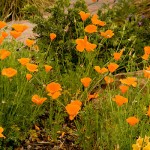Looking through the Sacramento Bee an article published recently popped out at me. The article talks about Sacramento area water use and limitations that this area will face in the near future. Most of the Sacramento area receives municipal water from a surface water source; water held in the Folsom Dam (Elk Grove is an exception being the only municipality in the area that relies on groundwater sources). According to the article “The Folsom Dam is a source of drinking water for some 500,000 people in the suburban Sacramento area. With no rain in the forecast, and the water level behind the dam shriveled to 18 percent of capacity after a dry start to winter, officials said dramatic conservation efforts are necessary.” Surface water, the river, is not only an important drinking water resource but a necessary resource for wildlife, such as spawning salmon. Water agencies are finding themselves stuck between a dry and a drier place.
Protecting wildlife and maintaining municipal supplies are critical issues. “Without reducing water releases to the river, and without a return to normal winter weather water agencies such as San Juan Water District would risk running out of water by March. At that point, the district’s water intake at Folsom Dame would be sucking air.” The article points out a deadline of March if actions are not taken to remedy our current situation. So, what are the solutions to this issues? The San Juan Water District Board of Directors will be asked to approve a ‘Stage 5’ drought restriction, this “would ban all outdoor watering, prohibit water from being used for construction activities, ban new connections to the water system, and call on customers to reduce indoor water use by 50 percent.”
San Juan isn’t the only Water District facing this issue, Folsom and Roseville have asked residents to cut water use by 20 percent and it is expected that the City of Sacramento will be soon to follow. But what does all of this mean for the area? A friend who is a landscape designer had a quick response, “It means… a whole lot of ugly!”
With the voluntary cut back in outdoor water-use, we are facing possible dead lawns, shrubs and trees. There are two possible options to address this challenge. One is to take this circumstance as an opportunity to remove turf, save water, and replace the turf with drought tolerant plants. The other options is to try to protect what we have.
Protecting Existing Landscaping during the drought
One of the LCWC’s former Board members, Mindy Cecchitinni, is a UC Master Gardener has shared some suggestions with us to provide sufficient water to keep our landscaping from dying during these difficult times. Here are some of her suggestions:
- If you are watering your lawn and flower beds on a regular basis now, please stop. There is no need to be watering anything on a regular basis.
- If you have containers that are planted, they should only need watering on a weekly basis. Don’t let the hose run until you have flooded your porch or deck or sidewalk or driveway.
- Our ornamental and fruit trees also need a drink, even though their root systems are deeper and wider. My recommendation is to hose water, running the water on low for several hours. It is difficult to know if the hose water is getting down to the roots without digging a hole, which is not recommended. However, tree roots have very small feeder roots that are attached to the larger roots, almost hair like, that function like a sponge, soaking up water and nutrients so chances are your trees will appreciate the occasional drink. If you have an irrigation system for your trees only, you should turn it on and let it run for several hours until you have soaked the area beneath the canopy.
- For your lawn…water about once every two weeks (if we have no precipitation), remember your grass roots are shallow which translates to the lawn needing less water to stay alive.
Replace the lawn
Another alternative is to take this opportunity to replace part or all of your lawn. Let is turn brown, install drip irrigation, and develop a plan to replant with drought-tolerant plants and groundcover. There are many places to obtain information to guide you in this process.
Several local organizations are great resources for more information to help you save water in your landscape.
Elk Grove Greener Gardens is working to organize their third annual Garden Tour & DIY Festival on April 26th. The Tour will give examples of residences that have alternative landscapes; the Festival will help you to implement these ideas on your property. The event is free and you can register on the Elk Grove Greener Gardens website and check out all or the resources they have to offer.
Ecolandscape California and Click here (RFL) are local organizations that will help you to cut back on outdoor water and make your landscape more beneficial. California Ecolandscape’s website can help you find a professional that can guide you through the process from design to maintenance. River Friendly Landscaping (RFL) is a great starting point and their Click hereis full of fantastic resources.
Use the RFL benefits calculator to see how much water, time and money can be saved by creating a river-friendly landscape.




Some resource extraction methods,(i.e. fracking) used in California are huge water consumers. Does the regulation of water ever extend to those businesses? Would it be a state regulation or county?
We should build another dam. Soon enough, the drought will end and the floods will begin. A new dam would allow us to save water for the dry years and slow the flow during the rainy season (so we don’t get flooded out). It wasn’t that many years ago (the 1990’s) when hundreds of houses in Placer and north-east Sacramento county were overcome with flood water.